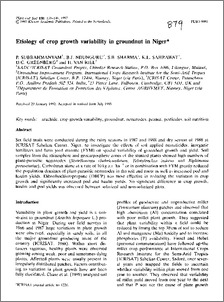Etiology of crop growth variability in groundnut in Niger
Abstract
Six field trials were conducted during the rainy seasons in 1987 and 1988 and dry season of 1988 at ICRISAT Sahelian Center, Niger, to investigate the effects of soil applied nematicides, inorganic fertilizers and farm yard manure (FYM) on spacial variability of groundnut growth and yield. Soil samples from thc rhizosphere and geocarposphere zones of the stunted plants showed high numbers of plant-parasitic nematodes (Scutellonema clathricaudatum, Telotylenchus indicus and Xiphinema parasetariae). Carbofuran alone at a rate of 10 kg a.i. ha or in combination with FYM greatly reduced the population densities of plant-parasitic nematodes in the soil and roots as well as increased pod and haulm yields. Dibromochloropropane (DBCP) was most effective in reducing thc variation in crop growth and significantly increased pod and haulm yields. No significant difference in crop growth, haulm and pod yields was observed between solarized and non-solarized plots

